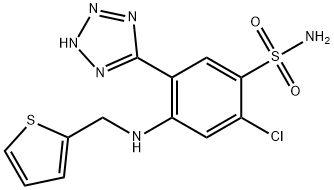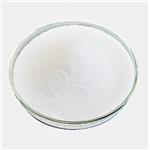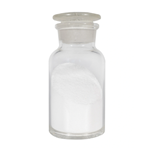Description
Azosemide is a high-ceiling diuretic similiar in structure and profile to furosemide, albeit somewhat less potent and less bioavailable. It is useful in the treatment of congestive heart failure and similar edematous conditions.
Originator
Boehringer Manheim (W. Germany)
Uses
Azosemide is a high-ceiling diuretic agent. It is used in the treatment of edematous states and hypertension.
Definition
ChEBI: A sulfonamide that is benzenesulfonamide which is substituted at positions 2, 4, and 5 by chlorine, (2-thienylmethyl)amino and 1H-tetrazol-5-yl groups, respectively. It is a diuretic that has been used in the management of oedema and hyp
rtension.
Manufacturing Process
The 4-chloro-5-sulfamoyl-2-thenylaminobenzonitrile used as starting material
is obtained by the reaction of 4-chloro-2-fluoro-5-sutfamoyl-benzonitrile with
thenylamine in anhydrous tetrahydrofuran.
Then the 5-(4'-chloro-5'-sulfamoyl-2'-thenylamino)phenyltetrazole (MP 218°
to 221°C, yield 37% of theory) is obtained by the reaction of 4-chloro-5-
sulfamoyl-2-thenylaminobenzonitrite (MP 170° to 174°C) with sodium azide
and ammonium chloride,
Therapeutic Function
Diuretic
Safety Profile
Poison by intraperitoneal andintravenous routes. Moderately toxic by ingestion andsubcutaneous routes. An experimental teratogen. Whenheated to decomposition it emits toxic fumes of Cl
-, SOx,and NOx.




